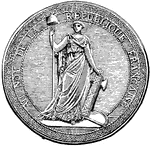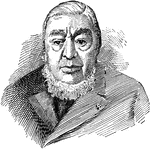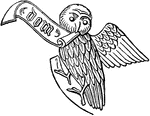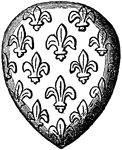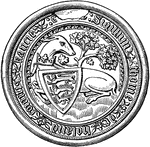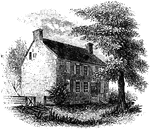
Whitall's House at Red Bank
"South of the fort a short distance was a brick house with 'I.A.W. 1748' on one of the gables, the initials…
Butt's Hill, Looking South
"The view is taken from the American intrenchments on Butt's Hill. he windmill is on Quaker Hill. The…
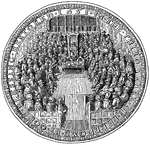
Great Seal of England Under the Commonwealth
The seal used to symbolize the monarch's approval of important state documents.

A Viking Ship
"It was the custom of Northmen to bury their dead sea king near the sea in his ship and over the spot…
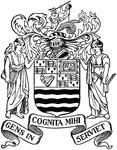
Seal of the Council for New England
The seal of the Council for New England, during the colonial era.

Great Seal of Andros
The seal of Sir Edmund Andros, the 3rd and 5th Royal Governor of colonial Maryland.

Seal of Sir Thomas Lucy
The official seal of Sir Thomas Lucy, a magistrate who persecuted recusant Catholic families. The seal…

Monogram of John Baret
"In the church of St. Mary, at Bury St. Edmunds, the ceiling of the eastern compartment of the south…
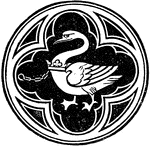
De Bohun Badge
"De Bohun badge. From the central spandrel of the Canopy of the Brass to Alianore de Bohun, Duchess…
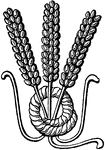
Badge of Abbot John de Wheathamstede
The heraldic badge of Abbot John de Wheathamstede. This badge has a rebus, or a visual pun representing…
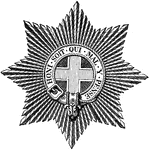
Star of the Order of the Garter
"The Star is the badge, first ordered by Charles I. The rays are of silver or diamonds. The star is…
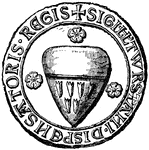
Seal of Thurstan
The heraldic seal of the archbishop of York, who worked under kings William II of England and Henry…
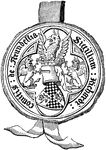
Seal of Richard, Earl of Arundel
"The Seal of Richard, Earl of Arundel, bears his achievement of arms. The supporters, crest, helm, etc.,…
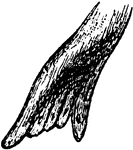
Foot of Seal
"Foot of the seal, which opens and closes in the act of natation, the organ being folded upon itself…

The Seal
"The seal, adapted principally for water. The extremities are larger than in the porpoise and manatee."—Pettigrew,…

The Turtle
"The turtle, adapted for swimming and diving, the extremities being relatively larger than in the seal,…

Pine Cone of Carolina Hemlock
Also known as Tsuga caroliniana. An evergreen coniferous tree native to the Appalachian Mountains.

Branch of Texas Cedar Elm
Also known as Ulmus crassifolia. The branch of a Texas Cedar Elm, native to to south central North America.

Branch of Magnolia Acuminata Cordata
The branch of a Magnolia acuminata cordata, mostly found on the Blue Ridge in South Carolina.

Branch of Persea Pubescens
A branch of a Persea pubescens tree, native to the coasts of the south Atlantic and Gulf of Mexico.

Branch of Ocotea Catesbyana
A branch of an Ocotea catesbyana tree. They are commonly found throughout tropical climates, including…

Adiantum Diaphanum Fern
The fronds on the adiantum diaphanum fern ranges from four to eight inches in height with long slender…
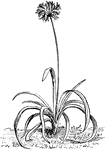
Agapanthus Umbellatus Flower
The agapanthus flower is commonly known as the African Lily. The umbellatus variety is bright blue and…
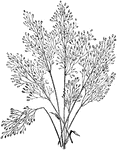
Aira Pulchella Grass
Aira pulchella is also known as air grass. The flower clusters are loose, delicate, and graceful. This…
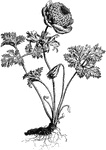
Anemone Coronaria Flore-Pleno Flower
Anemone Coronaria is known as Poppy Anemone. The flowers are found in various colors. The flower grows…
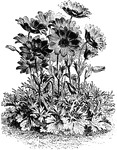
Anemone Fulgens Flower
The anemone fulgens flower is a dazzling scarlet color with a black central patch of stamens. This flower…
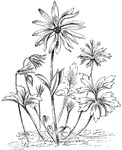
Anemone Stellata Flower
The flowers of anemone stellata come in several colors such as purple, rose red, or a whitish color.…

Anthurium Splendidum Flowers
The leaves of anthurium splendidum are heart shaped. The stem is short and thick. This plant grows in…
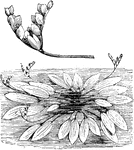
Habit and Flower-spikes of Aponogeton Distachyon
Aponogeton Distachyon is commonly known as Cape Pond Weed or Winter Hawthorn. It is an aquatic plant…

Training for Apricot Trees at Gable Ends of Cottages
Apricot trees can be trained at gable ends of cottages. The apricot tree prefers walls facing south-west…

Arum Dracunculus
Arum Dracunculus, sometimes known as the Dragon Arum, has a large purple spathe. This variety of arum…

Arundo Donax
Arundo Donax is commonly known as Great Reed. The flowers on this reed are reddish and ultimately whitish.…

Asplenium Radicans
Asplenium radicans fronds are shaped like a triangle. The fronds are between three and five feet long.…
